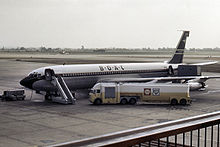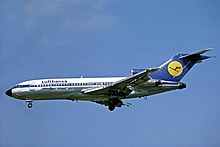History of Boeing
The aircraft was shipped disassembled by rail to the northeast shore of Lake Union, where Martin's pilot and handyman James Floyd Smith assembled it in a tent hangar.
He put the idea to his friend George Conrad Westervelt, a U.S. Navy engineer, who agreed to work on an improved design and help build the new airplane, called the "B&W" seaplane.
Boeing made good use of his Duwamish boatworks and its woodworkers under the direction of Edward Heath, from whom he bought it, in fabricating wooden components to be assembled at Lake Union.
The low drag airframe with cantilever wings and the retractable landing gear was so revolutionary that the engines and propellers of the time were not adequate to realize the potential of the plane.
[citation needed] The company aimed to recover quickly by selling its Stratocruiser (the Model 377), a luxurious four-engine commercial airliner derived from the C-97.
This was a monumental engineering and management challenge and included the construction of the world's biggest factory in which to build the 747 at Everett, Washington, a plant which is the size of 40 football fields.
In the early 1970s Boeing suffered from the simultaneous decline in Vietnam War military spending, the slowing of the space program as Project Apollo neared completion, the recession of 1969–70,[29]: 291 and the company's $2 billion debt as it built the new 747 airliner.
Then in March 1971, Congress voted to discontinue funding for the development of the Boeing 2707 supersonic transport (SST), the US's answer to the British-French Concorde, forcing the end of the project.
[40] In April 1994, Boeing introduced the most modern commercial jet aircraft at the time, the twin-engine 777, with a seating capacity of approximately 300 to 370 passengers in a typical three-class layout, in between the 767 and the 747.
[46][47] This had been delayed by objections from the European Commission, which ultimately placed 3 conditions on the merger: termination of exclusivity agreements with 3 US airlines, separate accounts would be maintained for the McDonnell-Douglas civil aircraft business, and some defense patents were to be made available to competitors.
[48] The New York Times made an observation described as prescient by Natasha Frost after the 737 Max crashes: "The full effect of the proposed merger on employees, communities, competitors, customers and investors will not be known for months, maybe even years.
[50][51][52][53] An aerospace analyst criticized the CEO and his deputy, Philip M. Condit and Harry Stonecipher, for thinking of their personal benefits first, and causing the problems to Boeing many years later.
However, the plane's fate was sealed by the changes in the commercial aviation market following the September 11 attacks and the subsequent weak economy and an increase in fuel prices.
In December 2003, the Pentagon announced the project was to be frozen while an investigation of allegations of corruption by one of its former procurement staffers, Darleen Druyun (who began employment at Boeing in January) was begun.
Druyun pleaded guilty to inflating the price of the contract to favor her future employer and to passing information on the competing Airbus A330 MRTT bid.
In June 2003, Lockheed Martin sued Boeing, alleging that the company had resorted to industrial espionage in 1998 to win the Evolved Expendable Launch Vehicle (EELV) competition.
Lockheed Martin claimed that the former employee Kenneth Branch, who went to work for McDonnell Douglas and Boeing, passed nearly 30,000 pages of proprietary documents to his new employers.
[92] In early September 2005, it was reported that Boeing was negotiating a settlement with the U.S. Department of Justice in which it would pay up to $500 million to cover this and the Darleen Druyun scandal.
[93] In July 2009, naturalized citizen Dongfan Chung, an engineer working with Boeing, was the first person convicted under the Economic Espionage Act of 1996.
[94] Chung is suspected of having passed to China classified information on designs including the Delta IV rocket, F-15 Eagle, B-52 Stratofortress and the CH-46 and CH-47 helicopters.
This became a major issue of contention, as the European side was equally concerned by subsidies accruing to U.S. LCA manufacturers through NASA and Defense programs.
[102] In summer 2010, Boeing acquired Fairfax, VA-based C4ISR and combat systems developer Argon ST to expand its C4ISR, cyber and intelligence capabilities.
[103] In 2011, Boeing was hesitating between re-engining the 737 or developing an all-new small airplane for which Embraer could have been involved, but the Airbus A320neo launch, with new engines, precipitated the 737 MAX decision.
In October 2017, Boeing announced plans to acquire Aurora Flight Sciences to expand its capabilities to develop autonomous, electric-powered and long-flight-duration aircraft for its commercial and military businesses, pending regulatory approval.
[126] On June 4, 2018, Boeing and Safran announced a 50-50 partnership to design, build and service auxiliary power units (APU) after regulatory and antitrust clearance in the second half of 2018.
[139][140] On April 23, 2019, the Wall Street Journal reported that Boeing, SSL and aerospace company The Carlyle Group had been helping the Chinese Peoples Liberation Army enable its mass surveillance on ethnic groups such as the Uighur Muslims in the Xinjiang autonomous region in northwestern China as well as giving a high-speed internet access to the artificial islands in the South China sea among others through the use of new satellites.
[144] The joint ventures with Embraer, for commercial and military aircraft, were both canceled in April 2020, as Boeing was heavily affected financially by the grounding of the 737 MAX and the impact of the 2019–20 coronavirus pandemic on aviation.
[148] In late April 2020, due to the 737 MAX grounding, Boeing left behind studies for the New Midsized Airplane/797 in favor of refreshments of its geriatric 757 and 767, alternatively called the 757-Plus and 767X.
On January 5 2024 a Boeing 737 Max 9 operating Alaska Airlines Flight 1282 suffered an uncontrolled decompression, after a door plug completely blew out from the aircraft.
On January 9, Boeing's president and CEO, Dave Calhoun acknowledged the company's mistake in a company-wide meeting on safety and transparency following this accident.






















